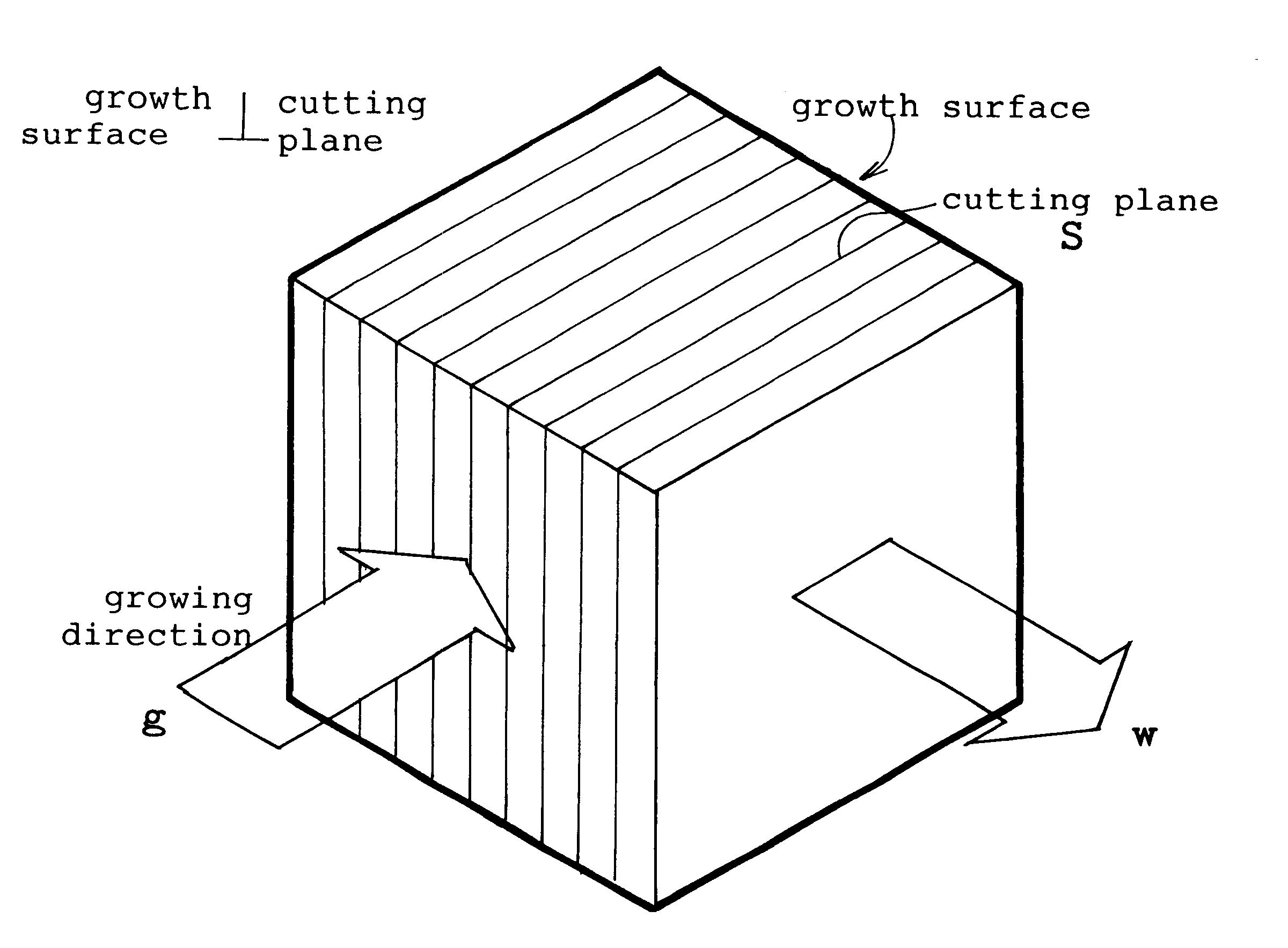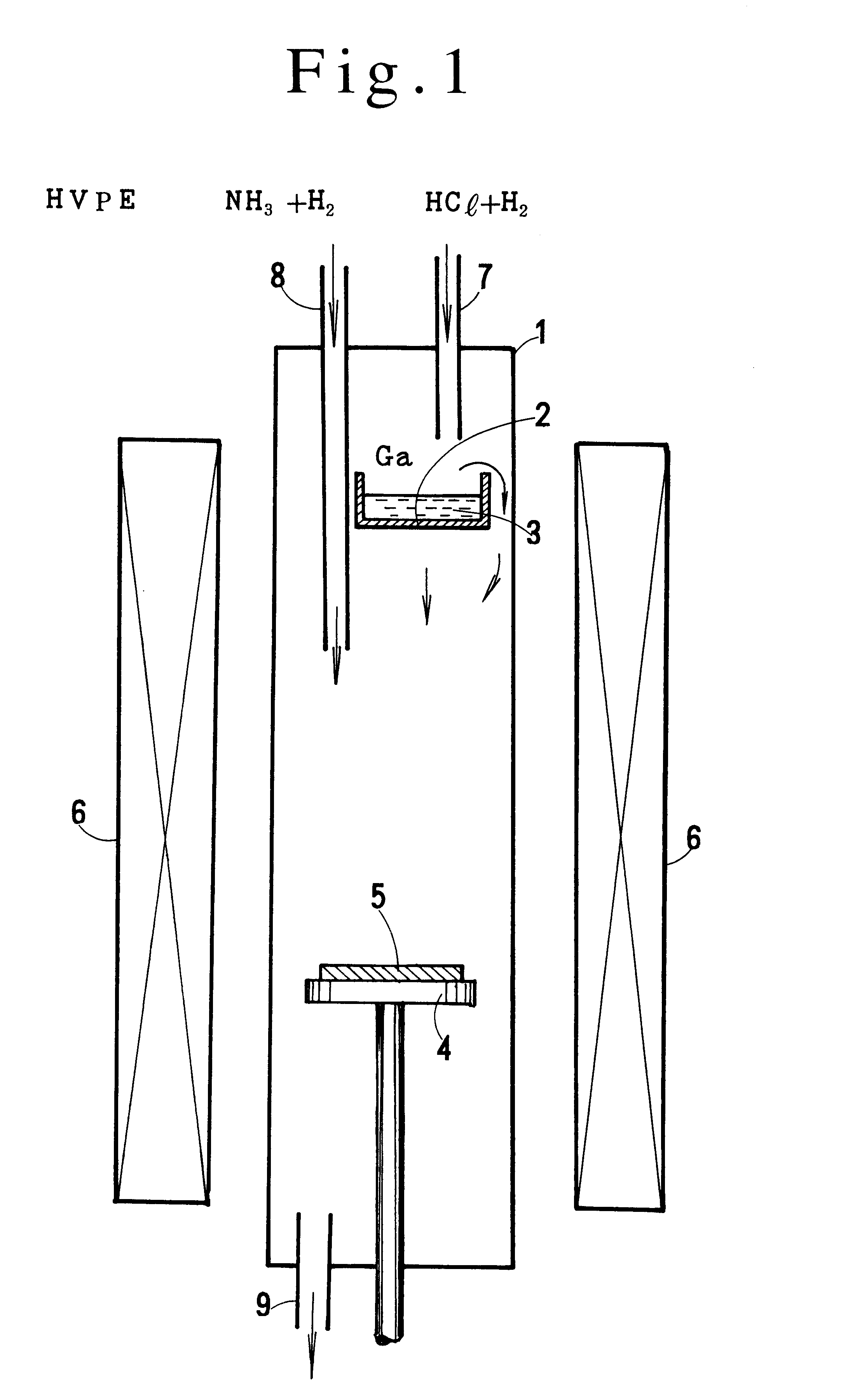Method of producing a single crystal gallium nitride substrate and single crystal gallium nitride substrate
a gallium nitride and substrate technology, applied in the direction of crystal growth process, monocrystalline material growth, semiconductor lasers, etc., can solve the problems of gan/sapphire lds to other difficulties, gan/sapphire lds to incur an extra cost,
- Summary
- Abstract
- Description
- Claims
- Application Information
AI Technical Summary
Benefits of technology
Problems solved by technology
Method used
Image
Examples
embodiment 1-c
(EMBODIMENT 1-c) Formation of Windows on the SiO.sub.2 Mask
Stripe-shaped, dot-shaped or other shaped windows are available. Here, dot-shaped windows are perforated on the mask. The disposition of the windows is the same as FIG. 2. The square windows are replaced by round dots. The dot has a diameter of about 2 .mu.m. As shown in FIG. 2, a series of windows are regularly aligned along a line extending in a GaAs direction by a 4 .mu.m pitch. Another series of windows are also regularly aligned along another line parallel with and being distanced from the former line by 3.5 .mu.m with half pitch off-set. The window pattern on the pairing lines are repeated in the GaAs [1-10] direction which is orthogonal to the GaAs direction. Namely all the series of windows deviate by 2 .mu.m in the GaAs direction from the neighboring series. Every neighboring three windows are laid on comers of an equilateral triangle of 4 .mu.m sides.
embodiment 1-d
(EMBODIMENT 1-d) HVPE Apparatus
The GaAs substrate with the window-carrying mask is laid upon the susceptor 4 in the furnace 1 of the HVPE apparatus as shown in FIG. 1. The HVPE apparatus is designed to be suitable for a long time growth. A GaN freestanding substrate requires a long time growth of GaN.
The Ga-boat 2 and the susceptor 4 are heated by the heater 6. The Ga is molten in the Ga-boat 2. A mixture of H.sub.2 and HCl gas is supplied to the Ga-melt 3 through the gas inlet 7. Another mixture of H.sub.2 and NH.sub.3 gas is replenished to a space above the susceptor 4 in the furnace 1.
HCl gas with a carrier H.sub.2 gas is supplied to the Ga-melt heated at about 800.degree. C. Reaction of HCl with Ga makes gallium chloride (GaCl) vapor. The GaCl vapor flows downward near the heated GaAs substrate 5 and reacts with ammonia gas NH.sub.3. The reaction synthesizes GaN. GaN molecules are piled upon the heated GaAs substrate 5. Piling of the GaN makes GaN isolated thin films in the wind...
embodiment 1-e
(EMBODIMENT 1-e) Formation of GaN Buffer Layers
The HVPE apparatus makes about 80 nm thick buffer layers upon the revealed surface of the GaAs substrate within the windows under the condition,
The mask SiO.sub.2 has a function of rejecting piling of GaN. No GaN film is deposited on the mask. Since the buffer layers (80 nm) are thinner than the thickness (100 nm) of the mask, the buffer layers are enclosed by the window walls and are separated from other buffer layers by the mask material. The buffer layers which are synthesized at a low temperature (500.degree. C.) play the role of alleviating the misfit of the lattice constants between GaN and GaAs.
PUM
| Property | Measurement | Unit |
|---|---|---|
| thickness | aaaaa | aaaaa |
| height | aaaaa | aaaaa |
| height | aaaaa | aaaaa |
Abstract
Description
Claims
Application Information
 Login to View More
Login to View More - R&D
- Intellectual Property
- Life Sciences
- Materials
- Tech Scout
- Unparalleled Data Quality
- Higher Quality Content
- 60% Fewer Hallucinations
Browse by: Latest US Patents, China's latest patents, Technical Efficacy Thesaurus, Application Domain, Technology Topic, Popular Technical Reports.
© 2025 PatSnap. All rights reserved.Legal|Privacy policy|Modern Slavery Act Transparency Statement|Sitemap|About US| Contact US: help@patsnap.com



